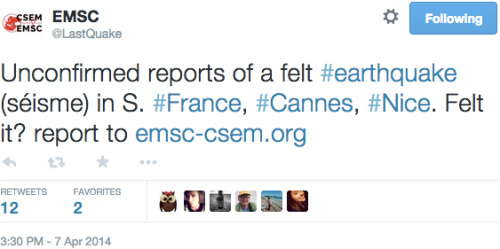Patrick Meier at iRevolutions: “It is said that our planet has a new nervous system; a digital nervous system comprised of digital veins and intertwined sensors that capture the pulse of our planet in near real-time. Next generation humanitarian technologies seek to leverage this new nervous system to detect and diagnose the impact of disasters within minutes rather than hours. To this end, LastQuake may be one of the most impressive humanitarian technologies that I have recently come across. Spearheaded by the European-Mediterranean Seismological Center (EMSC), the technology combines “Flashsourcing” with social media monitoring to auto-detect earthquakes before they’re picked up by seismometers or anyone else.
Scientists typically draw on ground-motion prediction algorithms and data on building infrastructure to rapidly assess an earthquake’s potential impact. Alas, ground-motion predictions vary significantly and infrastructure data are rarely available at sufficient resolutions to accurately assess the impact of earthquakes. Moreover, a minimum of three seismometers are needed to calibrate a quake and said seismic data take several minutes to generate. This explains why the EMSC uses human sensors to rapidly collect relevant data on earthquakes as these reduce the uncertainties that come with traditional rapid impact assessment methodologies. Indeed, the Center’s important work clearly demonstrates how the Internet coupled with social media are “creating new potential for rapid and massive public involvement by both active and passive means” vis-a-vis earthquake detection and impact assessments. Indeed, the EMSC can automatically detect new quakes within 80-90 seconds of their occurrence while simultaneously publishing tweets with preliminary information on said quakes, like this one:

In reality, the first human sensors (increases in web traffic) can be detected within 15 seconds (!) of a quake…(More)“

